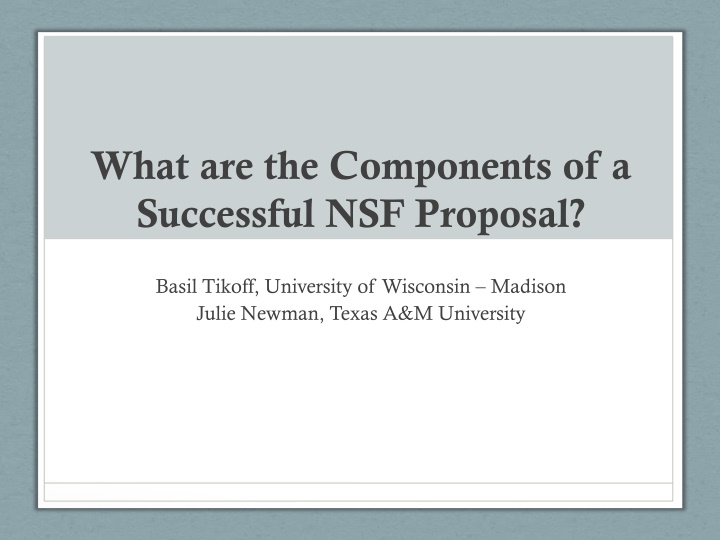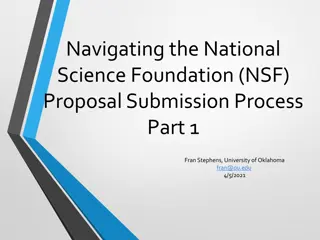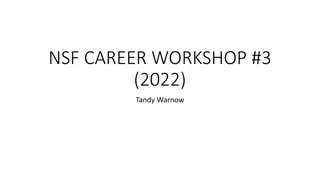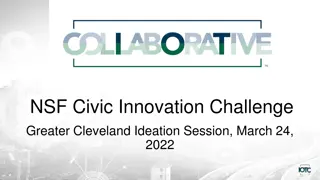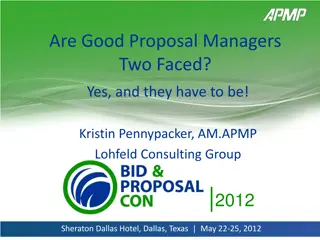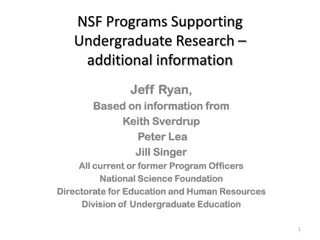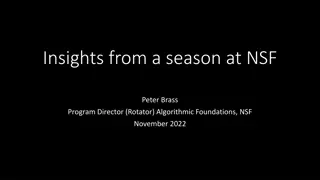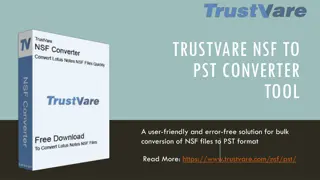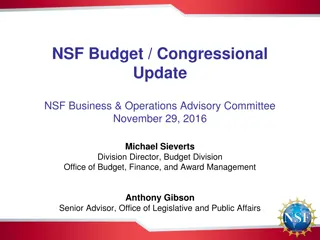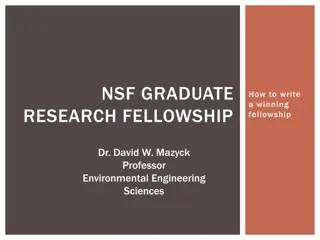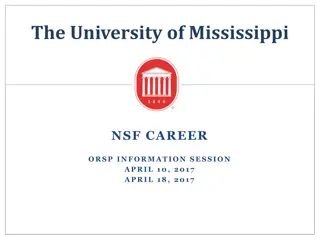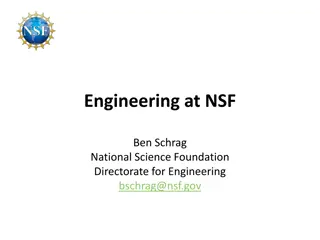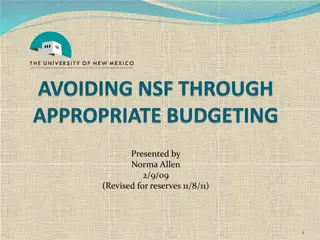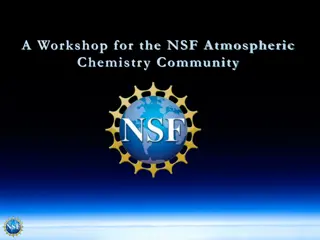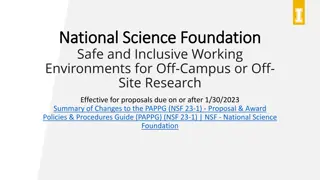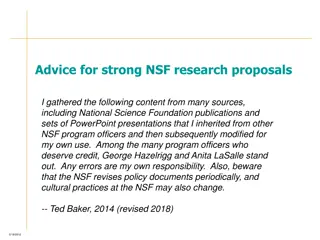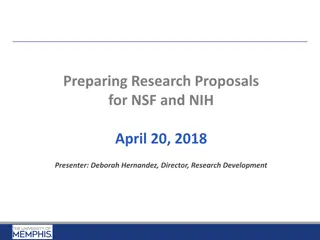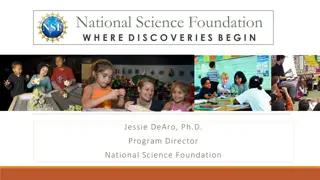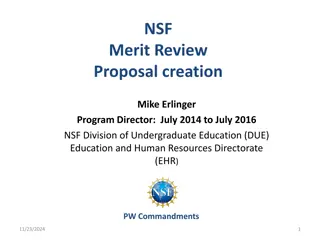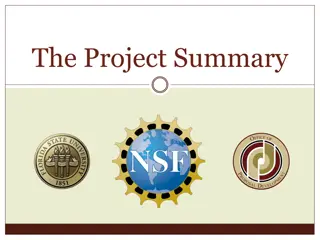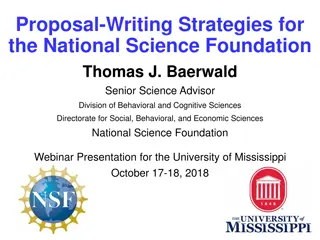Effective NSF Proposal Components and Review Process
Successfully navigating the NSF proposal process involves understanding the key components, review criteria, and overall process. Learn how to craft a compelling proposal, engage with program directors, address broader impacts, and consider single PI vs. multiple PI approaches for your research. Gain insights into the review process and strategies to enhance your proposal's competitiveness.
Download Presentation

Please find below an Image/Link to download the presentation.
The content on the website is provided AS IS for your information and personal use only. It may not be sold, licensed, or shared on other websites without obtaining consent from the author.If you encounter any issues during the download, it is possible that the publisher has removed the file from their server.
You are allowed to download the files provided on this website for personal or commercial use, subject to the condition that they are used lawfully. All files are the property of their respective owners.
The content on the website is provided AS IS for your information and personal use only. It may not be sold, licensed, or shared on other websites without obtaining consent from the author.
E N D
Presentation Transcript
What are the Components of a Successful NSF Proposal? Basil Tikoff, University of Wisconsin Madison Julie Newman, Texas A&M University
Things we said we should do How to follow read and understand an NSF program solicitation; What are all the parts of a successful proposal; When (and how) to contact an NSF program director; Understanding the review process; How to effectively present your proposal to both the reviewers and the panel; The importance of the broader impacts, and the many approaches to satisfying this component of the proposal; and The advantages and disadvantages of single PI vs. multiple PI proposals.
Overview Everyone introduces themselves We jabber at you about information we wish we had 20 years ago We will review a proposal and read reviews You can work on a NSF proposal and then discuss with people around you Do evaluation 5 minutes before departure (3:55)
Introductions Your name and affiliation? Which programs are you applying to? Any general/specific questions you hope to address? (Ask or use post-it notes anytime during the session)
How the process works You write a proposal, and by some miracle you get it done by the deadline. NSF Director sends it out to lots of people for review. Some of them review the proposal. NSF Director assembles a panel. Any individual panelist could read all or some of the the proposals. The panel meets at NSF. The panel will discuss all well ranked proposals. Panelists leave the room when a conflict of interest occurs. Panelists typically do not have a proposal, on which they are a PI, in that round. The panel is only advisory, although it is typically followed by Directors. The NSF Directors evaluate what proposals to fund after the Panel leaves.
Review - Formal Excellent Very good Good Poor Look at NSF website for definitions. To get a proposal funded, you typically need all excellent and very good reviews. For an expensive, collaborative proposal, it helps if the NSF director is excited about the work (or at least sees the value). Note: Although it may be entertaining to speculate about who gave you what review, you can never be certain.
Review Informal (& considering resubmittal) Excellent there will either be no useful comments OR the review will reveal that the proposal has problems but the reviewer can t bear to rank things badly Very good these are the gold for resubmittal. Reviewer often likes proposal but correctly recognizes a weakness Good the kiss of death for a proposal, as reviewer doesn t like it and is happy to tell you why. Sometimes, however, you get an inappropriate reviewer (and the panel recognizes that). Poor these are often ignored by panel as too curmudgeonly, unless multiple poor rankings are given Note: The panel has a lot more perspective than an individual reviewer, as they are informed by multiple reviewers. The panel summaries are VERY important for resubmittal.
General Advice When (and how) to contact your NSF program director: Complex proposals, EAGER or RAPID, expensive, out-of-the-norm broader impacts, etc. SRO Know the procedures at your university, and how much lead time they require for each step. Only submit very good work. If you are wondering whether it is good enough to submit, do not bother (unless you are unapologetic perfectionist in which case you should get a colleague to review)
Who should and shouldnt review NSF gives you the option to suggest reviewers and to suggest people who shouldn t review. The NSF directors may or may not adhere to those request (but probably will for the people who shouldn t review). We typically do not do this, and we don t really know what is the right thing to do. Other opinions?
Do you want to be involved in a big proposal? NSF has collaborative proposal for when more than one institution submits a budget for a specific proposal. Individual PI Small group PI Large group PI these are large advantages and large disadvantages to groups.
General Advice about co-PIs Work with someone (or group) that complements your strength. Don t work collaboratively with jerks. As a junior faculty, consider seeking out a nice and mellow senior scientist as a co-PI. Even if the grant isn t funded, you will learn about how to submit a good proposal from that person. Name recognition helps. See above point. You don t have to work with senior faculty. Junior faculty working together can work very well. But, if you need mentoring from a non co-PI, ask for it.
Getting back reviews: Suggestions Do not get angry. The reviewers are often trying to help you. Take a week off after you read them for the first time. Then, try to understand it from the perspective of the reviewer (who doesn t share your background) Ask for help of a senior colleague about how to resubmit it, given the comments (or if it is worth resubmitting) If you aren t getting funded, don t keep putting in the same proposal. Mix up your strategy or even what program you are applying to.
When to talk to NSF directors after rejection Do NOT call NSF directors if you are angry (or anyone else for that matter) Do NOT call if you think some reviews are unfair. There are always unfair reviews this is the role of the panel DO call them if you don t understand the panel summary. DO call them if you are a junior faculty and are getting very good reviews, but are not getting funded. You should ask for advice about how to improve the proposal (do NOT ask why isn t this proposal getting funded ).
Resource The Steve Marshak 12-step program
Writing the proposal Know your NSF/discipline initiatives Know your audience Hook your audience in first 1-2 pages Write for the short attention-spanned reviewer It is about sales must make problem interesting & important Follow through/Logical consistency how will your activities solve this problem/prove or disprove hypothesis? What goes into the proposal?
Intellectual Merit From NSF: Advancing knowledge and understanding within its own field or across different fields Qualifications of the proposer (individual or team) - quality of prior work Suggests and explores creative, original, or potentially transformative concepts Well conceived and organized Access to resources
Transformative Research From NSF: May revolutionize a discipline or disciplines May create a new field of research May disrupt accepted theories or perspectives From us: The transformative aspect is responding to a legitimate criticism that NSF typically does not fund the high-risk, high-reward research (because the reviewers are necessarily conservative). Do not claim your proposal is transformative, unless you can really explain why it is.
Broader Impacts Advance discovery and understanding while promoting teaching, training and learning Broaden the participation of underrepresented groups Enhance the infrastructure for research and education Disseminate the results broadly Potential benefits to society Note: Earth Science and Earth Science education is typically strong on broader impacts.
Review a proposal Read proposal Hook, Outline, Reviews Discuss with a partner Discuss with group Read reviews and panel summary What do they care about?
Hook? 1) The proposal must provide a clear statement of the problem. Not too broad, not too narrow. 2) The problem must pass the So what? test. The problem must be significant enough to be viewed as a good investment of taxpayers money. 3) The proposal must not appear to be bag shaking. 4) The proposal must provide working hypotheses that are testable, and the proposal must show how these hypotheses can be tested..
Outline? What to include Hook Planned activities, and how they will test hypothesis Broader Impacts (in clearly marked section) Workplan, indicating who will be responsible for which task. Timeline (Consider graphic for workplan and timeline) Anticipated results
Write a proposal In pairs or small groups, either: Work on outline or intro of in-progress proposal Or Brainstorm; start a proposal. Hook? Group discuss
Write a proposal In pairs or small groups, either: Work on outline or intro of in-progress proposal Or Brainstorm; start a proposal. Hook? Group discuss
